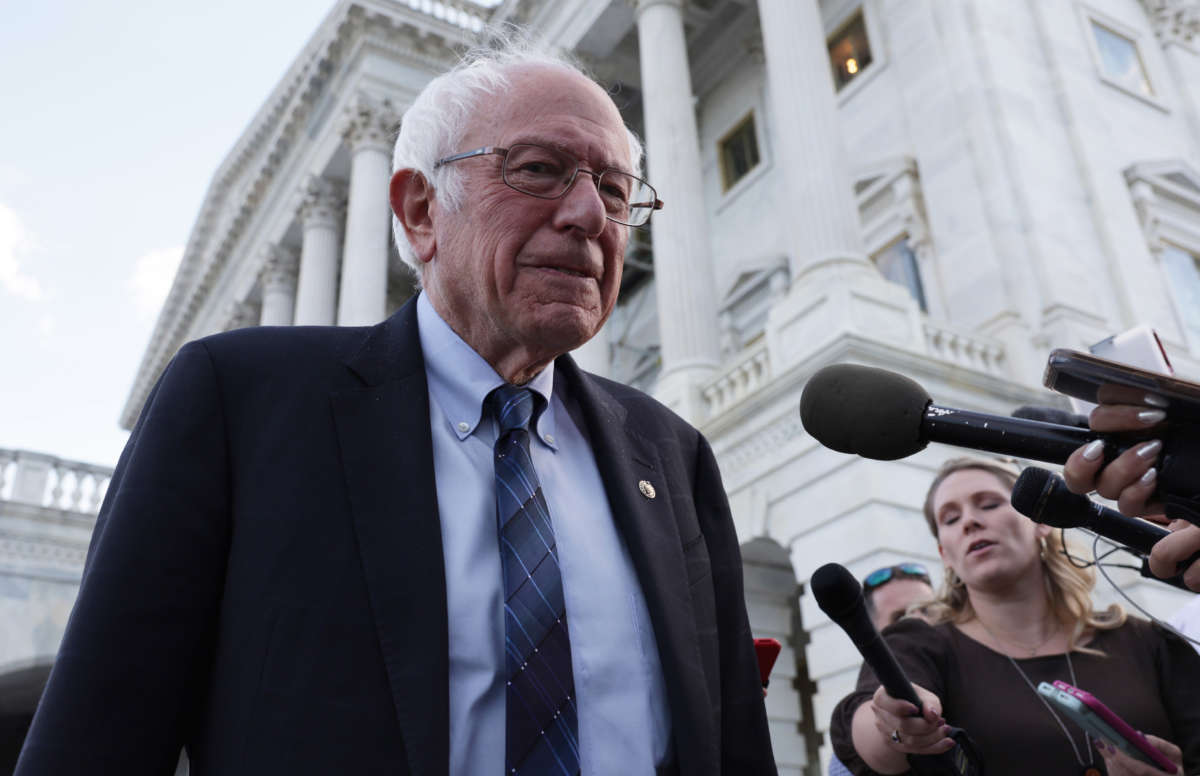As the wealth gap between middle-income Americans and the 1 percent balloons, Sen. Bernie Sanders (I-Vermont) is calling for redistribution of wealth from the wealthiest Americans to the middle and working classes as one of the first steps needed to save the country from the far right and “restore democracy.”
In an interview with CBS on Tuesday, Sanders said that Democrats need to recognize that billionaires are only getting richer and richer, while workers are falling behind – and, as long as this trend continues, people will keep losing faith in the idea that the government exists to work for them.
“Right now, a lot of people are losing faith in government,” he said. “If you are a worker out there – and your job went to China, your job went to Mexico, you’re making less than you used to make, your kid can’t afford to go to college, you can’t afford health care – and somebody puts a 30 second ad up on CBS, ‘vote for me,’ [you’d] say ‘go to hell. You’re all the same, you’re not doing anything for me.’”
“You want to restore democracy? Have a government that works for ordinary people,” he said.
When asked about the threat to the U.S. from the far right and Donald Trump, Sanders said that a large problem is that voters and regular people don’t see candidates that vow to work for them.
“You’re not going to hear it much on corporate television. I happen to believe we need redistribution of wealth in this country. We need to protect the middle class and working class, and the billionaires cannot have it all,” he said.
While there has been a redistribution of wealth over the past half century, he said, it has “gone in the wrong direction.” “We’re talking about trillions of dollars going to the 1 percent while the working class and the middle class become poorer,” he emphasized.
Indeed, according to a report commissioned by Sanders and released by the Congressional Budget Office (CBO) on Tuesday, the share of all wealth held by the top 1 percent shot up from 27 to 34 percent between 1989 and 2019, while wealth held by the bottom half of Americans dropped from 4 percent to 2 percent over the same period.
Overall, in 2019, while the bottom 50 percent of Americans owned $2.3 trillion in wealth, the top 10 percent owned $82.4 trillion, the report found.
These 2 graphs really tell the story.
Average wealth –>
Top 10%, 1989: $2.5M
Top 10% 2019: $6.4MBottom 25%, 1989: $0
Bottom 25%, 2019: -$11K pic.twitter.com/7O3WNNd1Ge— Jeff Stein (@JStein_WaPo) September 28, 2022
Student debt has been a major factor in the suppression of the wealth of the bottom 25 percent. In 2019, according to the report, student debt was the largest source of debt among the bottom 25 percent, surpassing the amount of debt from mortgages and credit cards combined.
The wealth gap has likely grown throughout the pandemic. Though pandemic provisions like the child tax credit and the stimulus checks kept millions of Americans afloat through the first two years of the pandemic, those financial programs are now over – while the economy remains unstable and inflation remains high.
On the flip side, however, U.S. billionaires have added over $1.7 trillion to their collective wealth since the start of the pandemic, much of this growth accruing to the very richest people in the world. According to a January Oxfam report, the world’s 10 richest people have doubled their wealth during the COVID-19 pandemic, adding $5 trillion to their collective wealth – or more than two times the $2.3 trillion total wealth owned by the bottom 50 percent of Americans in 2019.
Our most important fundraising appeal of the year
December is the most critical time of year for Truthout, because our nonprofit news is funded almost entirely by individual donations from readers like you. So before you navigate away, we ask that you take just a second to support Truthout with a tax-deductible donation.
This year is a little different. We are up against a far-reaching, wide-scale attack on press freedom coming from the Trump administration. 2025 was a year of frightening censorship, news industry corporate consolidation, and worsening financial conditions for progressive nonprofits across the board.
We can only resist Trump’s agenda by cultivating a strong base of support. The right-wing mediasphere is funded comfortably by billionaire owners and venture capitalist philanthropists. At Truthout, we have you.
We’ve set an ambitious target for our year-end campaign — a goal of $250,000 to keep up our fight against authoritarianism in 2026. Please take a meaningful action in this fight: make a one-time or monthly donation to Truthout before December 31. If you have the means, please dig deep.
